Wind and solar prices soar, making them the most expensive electricity sources in Minnesota
Wind and solar electricity prices are soaring in response to supply chain disruptions, rising costs for materials and labor, interest rate hikes, and increasing costs to connect wind and solar projects to the broader transmission system. As a result, wind and solar are Minnesota’s most expensive forms of electricity.
Subsidized costs are soaring
Prices for wind and solar electricity continue to climb despite the passage of the so-called Inflation Reduction Act (IRA), which renewed and expanded federal subsidies for these energy resources.
According to Edison Energy’s first quarter (Q1) report, the median cost of wind and solar power purchase agreements (PPAs) in the Midcontinent Independent Systems Operator (MISO) system, the regional grid to which Minnesota belongs, has increased substantially since 2021.
For example, Figure 1 shows solar PPAs in MISO have increased from around $34 per megawatt-hour (MWh) in Q1 2021 to around $63/MWh in Q1 2023, an increase of 85 percent. During this same period, wind PPAs increased from around $31/MWh to $55/MWh, an increase of 77 percent.
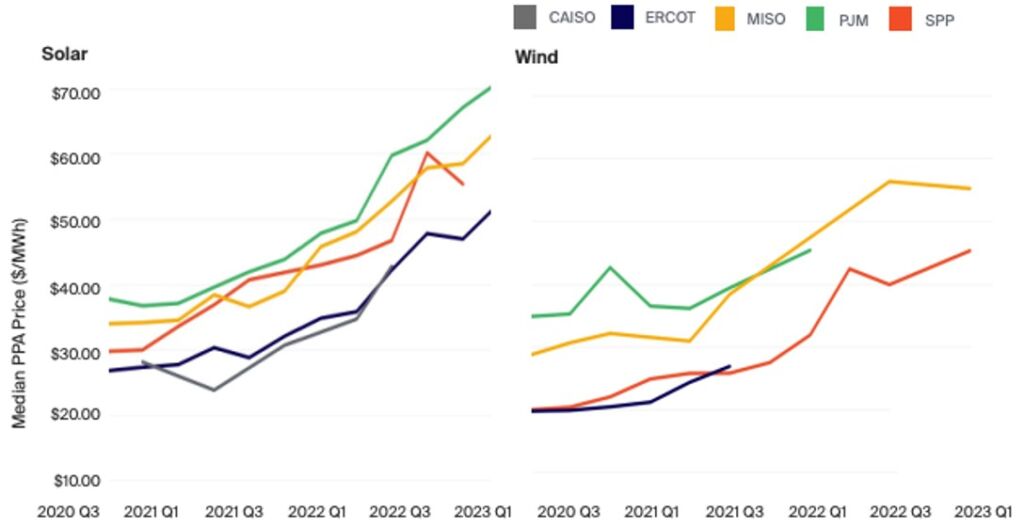
It is important to remember that PPA prices are the cost of wind and solar electricity after federal subsidies, such as the Investment Tax Credit (ITC) for solar and Production Tax Credit (PTC) for wind, have been subtracted from the ultimate cost, which means the unsubsidized cost of these energy sources is even higher.
The unsubsidized cost of wind and solar
Understanding the unsubsidized cost of solar is important because subsidies do not reduce the cost of providing a good or a service; they simply transfer some of the cost to taxpayers through higher tax burdens.
Mitch Rolling calculated the unsubsidized cost of electricity from wind and solar in Minnesota from 2012 through 2023 using historical cost data from the U.S. Energy Information Administration’s Electricity Market Module, Minnesota-specific figures for capacity factors (20.4 percent for new solar, and 45 percent for new wind), and a weighted average cost of capital (WACC) of 7.36 percent, which is consistent with utility costs throughout the country.
Figure 2 shows unsubsidized wind prices rose from $39.12 in 2019 to $62.91 per MWh, a nearly 61 percent increase, and solar prices rose from $70.46 in 2020 to $103.83 in 2023, an increase of 47 percent. The rising prices stand in stark contrast to common claims made by wind and solar advocates that these sources of electricity will always get cheaper.
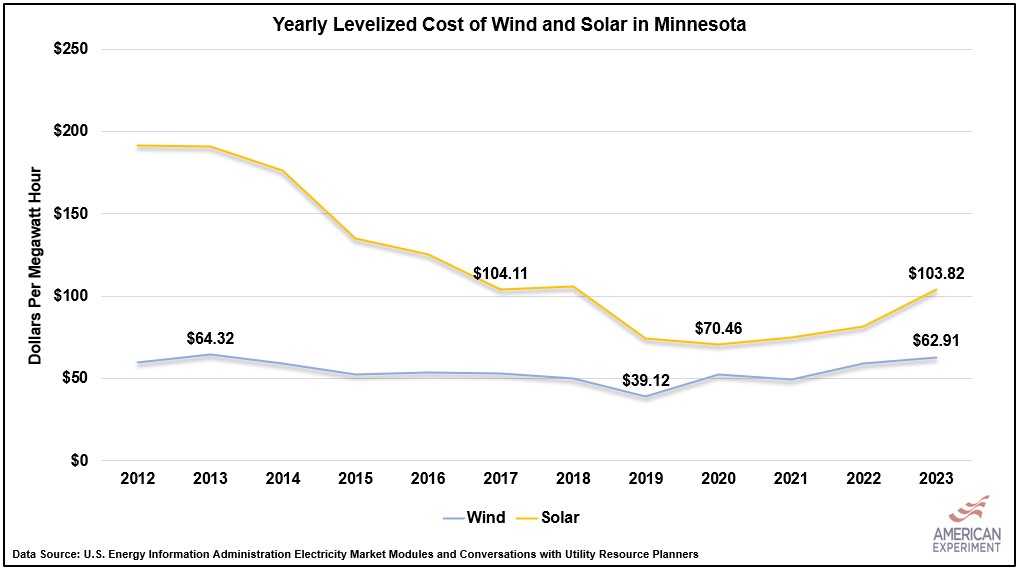
These prices do not include other critical factors for running a system on wind and solar, such as additional transmission costs or the cost of natural gas or battery backup. As a result, the costs discussed in Figure 2 do not represent the full system cost of using more wind and solar.
The most expensive electricity in Minnesota
Rising wind and solar prices have made these sources the most expensive means of generating electricity in Minnesota by a substantial margin. American Experiment found new wind is twice as expensive as the electricity generated by the Sherburne County (Sherco) coal plants, and new solar is 3.3 times more expensive, see Figure 2.
New wind and solar are also more expensive than the state’s existing natural gas and nuclear plants, as shown in Figure 2. All of the data for the existing power plant costs shown in Figure 3 were obtained using Federal Energy Regulatory Commission Form 1 data.
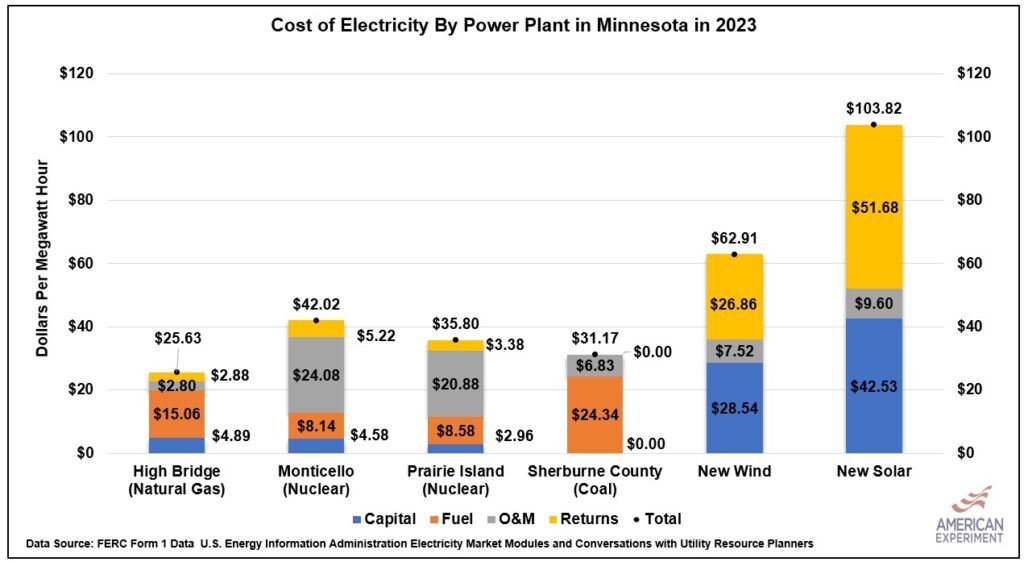
Rising solar prices are especially problematic in Minnesota because Xcel Energy plans to shut down Unit 2 at Sherco at the end of this year and replace this lost generating capacity with a massive solar installation.
Based on current solar prices, Minnesota families and businesses with Xcel as their electricity provider would be forced to pay 3.3 times more for this solar electricity than power generated at Sherco, plus the cost of additional transmission and natural gas backup power plants. In the end, everyone will pay more money for less reliable electricity.
Why are wind and solar costs rising?
The key reason for rising wind and solar electricity costs is an increase in prices for wind turbines and solar panels, shown in Figure 4. EIA data and conversations with utility resource planners indicate that the years of cost declines for these electricity generators have reversed, with overnight capital costs for wind turbines reaching a new all-time high and solar panels reaching levels not seen since 2017.
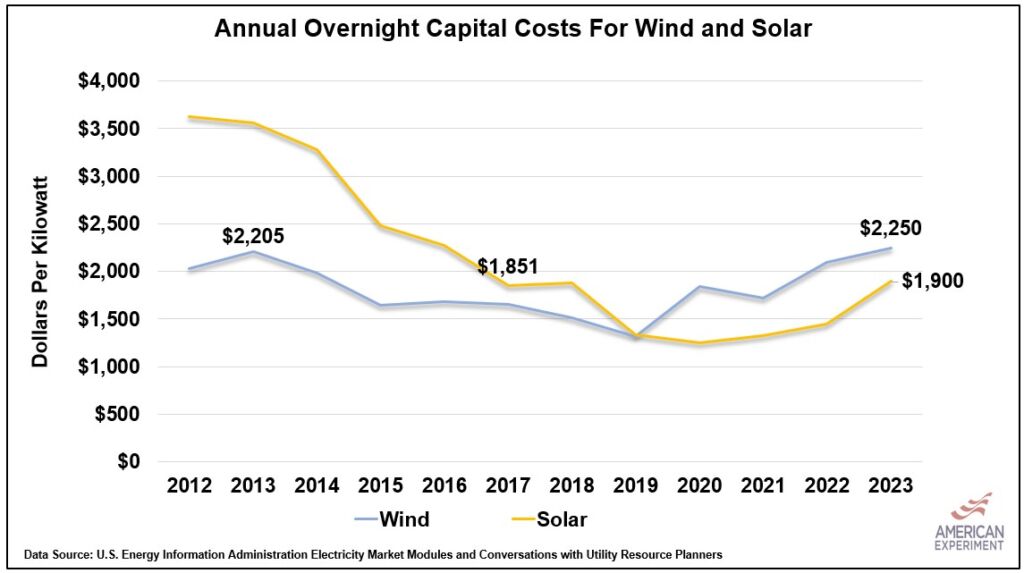
According to an April article in Energy Monitor, wind turbine prices have risen due to higher costs for steel, copper, zinc, manganese, chromium, nickel, molybdenum, and rare earths, as shown in Figure 5.
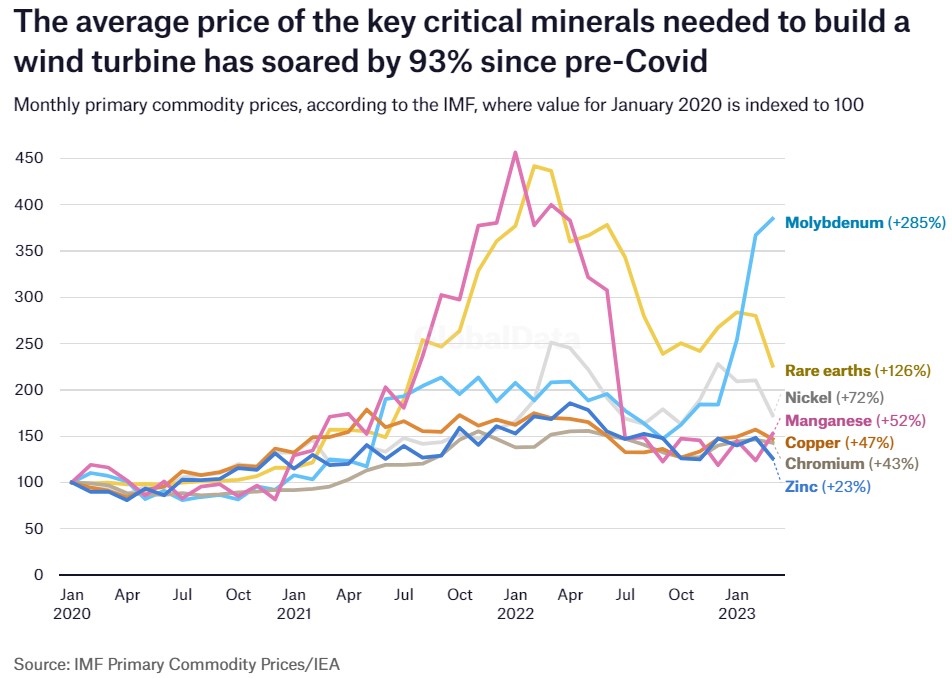
Solar costs are rising due to tariffs levied on components of Chinese origin for violating anti-dumping laws, restrictions on raw materials produced in Xinjiang province due to the use of slavery in the solar supply chain, and rising input costs. Taken together, costs are up nearly 50 percent.
Conclusion
Wind and solar will not always get cheaper, as we have seen from independent PPA data and our calculations based on rising wind turbines and solar panels costs. These rising prices should have important implications for energy policy in Minnesota, but unfortunately, they probably won’t.
Instead of shutting down reliable, low-cost coal-fired power plants, we should keep them open for as long as possible to ensure Minnesota families do not suffer from electricity price inflation.
Replacing these coal plants with new nuclear power facilities would be the best way to replace the reliable electricity they generate while reducing emissions. However, liberal lawmakers refused to legalize new nuclear power plants despite mandating the state obtain 100 percent of its electricity from carbon-free sources by 2040. All of this means skyrocketing costs and declining reliability ahead.